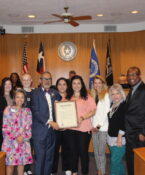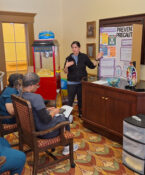Hispanic Heritage Month offers history lessons while celebrating diversity
For Alex Fernandez, connecting with his Cuban-American roots is a lifelong lesson.
“The more I learn, the more I appreciate where I came from,” said Fernandez, a Student Services Coordinator in the Office of Care and Civility at The University of North Texas Health Science at Fort Worth (HSC).
Fernandez, who grew up in Miami, said highlighting the triumphs and accomplishments of Hispanics is important during Hispanic Heritage Month, a national observance that starts on Sept. 15 and continues through Oct. 15.
For 30 days, communities, schools, colleges and other institutions highlight the histories, cultures, traditions, accomplishments, and ancestral roots of Americans with ties to Spain, Mexico, the Caribbean and Latin America.
The observation started in 1968 as Hispanic Heritage Week and was signed into law by President Lyndon Baines Johnson. It was expanded to 30 days by President Ronald Reagan in 1988.
“I think the significance of celebrating Hispanic Heritage Month is that, like many other people who have come to this country, Hispanics have also built the country,” said Desiree Ramirez, Senior Vice President & Chief Integrity Officer for the HSC Office of Institutional Integrity & Awareness.
Ramirez, who is Panamanian American, said immigrants from countries such as Mexico, Cuba, Puerto Rico and Panama are part of this nation’s story. She said it is important to acknowledge that Hispanics made contributions in art, history, culture, science, health and industry.
“Hispanic Americans have touched all of it and they have helped build the fabric of the country,” Ramirez said. “I think it is important to celebrate and acknowledge that because that history has to be part of American history.”
HSC strives to build a diverse academic, research institution of higher learning. Those efforts include showcasing the work of Hispanic students, faculty, and staff while recognizing outreach that serves Latino patients and communities.
The University’s Hispanic community includes students, faculty, and staff with ties to Mexico, the Caribbean and Latin America.
“Hispanic culture is rich – there is a ton of variety in Hispanic culture,” Fernandez said, explaining that Hispanic cultures and traditions vary from Spanish-speaking region to region.
Fernandez said taking the time to learn more about different Hispanic art, customs and traditions that exist can be rewarding.
“There are artists, musicians and architecture – tons of beautiful things – that you would never know came from the Hispanic community,” Fernandez said.
Brian Rodriguez, an Administrative Associate with the Office of Care and Civility, said celebrating one’s Hispanic roots is one way the community can find its collective voice.
“With the Hispanic population growing so rapidly, it is one of those things that we know we are here, but we don’t know who we are – if that makes sense,” Rodriguez said, who describes himself as Mexican American.
“I think finding out about who we are and our past is important – it’s important to learn about our history,” Rodriguez said.
Do you want to learn more?
National Archives and Records Administration
National Endowment for the Humanities
Smithsonian Education – Hispanic Heritage Month
UNT University Libraries Multicultural Center & Resources: Hispanic Latinx Heritage Month
Source: The Library of Congress
Donate to the Scholarships Fund
Graduate School is an investment. Parents save dollars to help loved ones fulfill professional ambitions such as becoming the family’s first doctor or pharmacist. Students juggle jobs and graduate studies to pay tuition bills.
Scholarships help ease the financial burden and bring peace of mind to students. Growing HSC’s scholarship pool would allow us to help more students.




![Uyen Sa Nguyen Scaled[58]](https://www.unthsc.edu/newsroom/wp-content/uploads/sites/16/Uyen-Sa-Nguyen-scaled58-145x175.jpg)

Social media